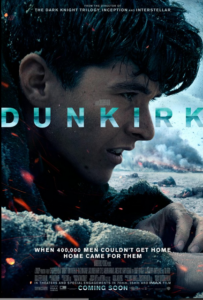
 “Wars are not won by evacuations.” British Prime Minister Winston Churchill said this in a speech on June 4, 1940.
“Wars are not won by evacuations.” British Prime Minister Winston Churchill said this in a speech on June 4, 1940.
Marked by subtle moments of epic silence and a unique structure, writer/director Christopher Nolan’s “Dunkirk” is a timeless classic. Destined to improve upon multiple viewings, Nolan’s distinct narrative unfolds delicately even as the chaos and deafening tragedy of the historical events are horribly on display.
The film expert focus is on the Dunkirk evacuation. Code-named Operation Dynamo, the massive rescue effort took place between May 26 and June 4, 1940. Instead of giving us exposition and backstory context, the narrative opens with a few lines of text simply setting the stage. The Battle of France and, specifically, the Battle of Dunkirk, did not go well and hundreds of thousands of British troops are stranded on the beaches and harbor of Dunkirk. Rescue endeavors are on-going, but it is a slow go. German bombers and fighters ruthlessly attack and hope is fading.
British infantryman Tommy (Fionn Whitehead) wanders through the town of Dunkirk looking for food, water, and safety. He soon finds that the beach might be a relatively better place. As British ships are bombed, evacuation efforts become stunted. The British government turns to civilian boats to help bring their boys home. Crossing the English Channel to Dunkirk was some 55 nautical miles, but the problem was that larger ships could not get close enough to retrieve the men from the beach or the mole that projects out into the sea. This is where some 800 smaller civilian boats became crucial.
While the history may be easy to review, confirming that the evacuation was successful, Nolan’s telling of the event is a special moment in cinema. Rated PG-13 for intense war experiences and some language, this is a film that is appropriate for almost any viewer over the age of 10. That’s right, Nolan and his team have so carefully constructed this movie that we get enough of the horrors of war without completely sanitizing it. Sure, some will be sniffy that we aren’t thrust into the grisly and visceral horrors with mangled men suffering from wounds. But this isn’t that kind of war film. In fact, it isn’t arguably a war story at all.
British and French forces clearly made mistakes by wildly miscalculating the strength of the German opposition empowered with the blitzkrieg. But by the time Nolan’s “Dunkirk” begins, the battle has essentially ended. What remains is a retreat and a fight to bring the men home to safety. The war narrative gives way to one about an evacuation, a survival story.
And Nolan is intent on celebrating the elements of that evacuation effort. To that end, we are given a personal story about Mr. Dawson (Mark Rylance) and his boys, who make the decision to do their part and pilot Dawson’s civilian craft over the Channel and into the danger that awaits. This decision is a selfless act made at a difficult time. Dawson and his boys aren’t military men, but this mission required someone from outside the military establishment, and hundreds of civilians like Dawson stepped up.
As the effort to rescue the soldiers from the frothy beaches progresses, a battle does rage in the air. British pilot Farrier (Tom Hardy) engages German fighters and bombers in dogfights. But instead of glamorizing these aerial conflicts, Nolan gives us a toned down sound design in which the roar of the plane is often muffled and drowned out by the frustrating percussion of machine gun bullets. The effect is just as harrowing as the normal assaultive dogfight sounds we’ve come to expect from other war pictures. And one moment in particular should put a lump in viewers’ collective throats.
Performances are uniformly good but no one actor dominates making “Dunkirk” a true ensemble epic. Oscar winner Rylance gives his character humility with a tender, understated delivery. Dawson is a man of simple morals and commitment who acknowledges that war is necessarily tragic. Wide-eyed Fionn Whitehead receives the most screen time playing a fresh young soldier trying to do anything to leave the beach for the safety of home. His character’s foil is another young soldier played very well by pop star Harry Styles. Nolan regular Cillian Murphy inhabits tortured and shivering as a shell-shocked survivor, and Kenneth Branagh brings some heft to a naval commander who is intent on remaining on the mole until his last man is rescued.
Nolan works with his “Interstellar” cinematographer Hoyte Van Hoytema to craft a beautiful image that never reminds you that the camera is present. We get aerial scenes, shots on the beach, on the ocean, and even under water. The pallet is seamless throughout and never distracting.
Possibly Nolan’s best film, which is saying a lot, the story does not misstep. Because of the unique structure, Nolan is able chronicle quite nearly the entire event while keeping the running time relatively short, particularly by his standards. The war may not have been won with an evacuation, but Churchill’s admission that the battle was a “colossal military disaster” could not diminish his recognition that the evacuation was a “miracle of deliverance.” And that miracle meant the world.

